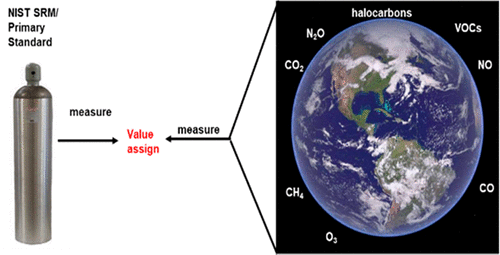当前位置:
X-MOL 学术
›
Anal. Chem.
›
论文详情
Our official English website, www.x-mol.net, welcomes your
feedback! (Note: you will need to create a separate account there.)
NIST Standards for Measurement, Instrument Calibration, and Quantification of Gaseous Atmospheric Compounds
Analytical Chemistry ( IF 6.7 ) Pub Date : 2018-03-02 00:00:00 , DOI: 10.1021/acs.analchem.7b05310 George C. Rhoderick 1 , Michael E. Kelley 1 , Walter R. Miller 1 , James E. Norris 1 , Jennifer Carney 1 , Lyn Gameson 1 , Christina E. Cecelski 1 , Kimberly J. Harris 1 , Cassie A. Goodman 1 , Abneesh Srivastava 1 , Joseph T. Hodges 1
Analytical Chemistry ( IF 6.7 ) Pub Date : 2018-03-02 00:00:00 , DOI: 10.1021/acs.analchem.7b05310 George C. Rhoderick 1 , Michael E. Kelley 1 , Walter R. Miller 1 , James E. Norris 1 , Jennifer Carney 1 , Lyn Gameson 1 , Christina E. Cecelski 1 , Kimberly J. Harris 1 , Cassie A. Goodman 1 , Abneesh Srivastava 1 , Joseph T. Hodges 1
Affiliation

|
There are many gas phase compounds present in the atmosphere that affect and influence the earth’s climate. These compounds absorb and emit radiation, a process which is the fundamental cause of the greenhouse effect. The major greenhouse gases in the earth’s atmosphere are carbon dioxide, methane, nitrous oxide, and ozone. Some halocarbons are also strong greenhouse gases and are linked to stratospheric ozone depletion. Hydrocarbons and monoterpenes are precursors and contributors to atmospheric photochemical processes, which lead to the formation of particulates and secondary photo-oxidants such as ozone, leading to photochemical smog. Reactive gases such as nitric oxide and sulfur dioxide are also compounds found in the atmosphere and generally lead to the formation of other oxides. These compounds can be oxidized in the air to acidic and corrosive gases and contribute to photochemical smog. Measurements of these compounds in the atmosphere have been ongoing for decades to track growth rates and assist in curbing emissions of these compounds into the atmosphere. To accurately establish mole fraction trends and assess the role of these gas phase compounds in atmospheric chemistry, it is essential to have good calibration standards. The National Institute of Standards and Technology has been developing standards of many of these compounds for over 40 years. This paper discusses the development of these standards.
中文翻译:

用于气态大气化合物的测量,仪器校准和定量的NIST标准
大气中存在许多影响并影响地球气候的气相化合物。这些化合物吸收和发射辐射,这是造成温室效应的根本原因。地球大气中的主要温室气体是二氧化碳,甲烷,一氧化二氮和臭氧。一些卤代烃也是强温室气体,与平流层臭氧消耗有关。碳氢化合物和单萜类化合物是大气光化学过程的前体和贡献者,这些过程导致形成微粒和二次光氧化剂(例如臭氧),从而导致光化学烟雾。一氧化氮和二氧化硫等反应性气体也是大气中发现的化合物,通常会导致其他氧化物的形成。这些化合物可在空气中被氧化成酸性和腐蚀性气体,并导致光化学烟雾。几十年来,一直在对大气中的这些化合物进行测量,以追踪其增长率并帮助遏制这些化合物向大气中的排放。为了准确确定摩尔分数趋势并评估这些气相化合物在大气化学中的作用,必须具有良好的校准标准。美国国家标准技术研究所已经开发了许多这类化合物的标准已有40多年的历史了。本文讨论了这些标准的发展。几十年来,一直在对大气中的这些化合物进行测量,以追踪其增长率并帮助遏制这些化合物向大气中的排放。为了准确确定摩尔分数趋势并评估这些气相化合物在大气化学中的作用,必须具有良好的校准标准。美国国家标准技术研究所已经开发了许多这类化合物的标准已有40多年的历史了。本文讨论了这些标准的发展。几十年来,一直在对大气中的这些化合物进行测量,以追踪其增长率并帮助遏制这些化合物向大气中的排放。为了准确确定摩尔分数趋势并评估这些气相化合物在大气化学中的作用,必须具有良好的校准标准。美国国家标准技术研究所已经开发了许多这类化合物的标准已有40多年的历史了。本文讨论了这些标准的发展。
更新日期:2018-03-02
中文翻译:

用于气态大气化合物的测量,仪器校准和定量的NIST标准
大气中存在许多影响并影响地球气候的气相化合物。这些化合物吸收和发射辐射,这是造成温室效应的根本原因。地球大气中的主要温室气体是二氧化碳,甲烷,一氧化二氮和臭氧。一些卤代烃也是强温室气体,与平流层臭氧消耗有关。碳氢化合物和单萜类化合物是大气光化学过程的前体和贡献者,这些过程导致形成微粒和二次光氧化剂(例如臭氧),从而导致光化学烟雾。一氧化氮和二氧化硫等反应性气体也是大气中发现的化合物,通常会导致其他氧化物的形成。这些化合物可在空气中被氧化成酸性和腐蚀性气体,并导致光化学烟雾。几十年来,一直在对大气中的这些化合物进行测量,以追踪其增长率并帮助遏制这些化合物向大气中的排放。为了准确确定摩尔分数趋势并评估这些气相化合物在大气化学中的作用,必须具有良好的校准标准。美国国家标准技术研究所已经开发了许多这类化合物的标准已有40多年的历史了。本文讨论了这些标准的发展。几十年来,一直在对大气中的这些化合物进行测量,以追踪其增长率并帮助遏制这些化合物向大气中的排放。为了准确确定摩尔分数趋势并评估这些气相化合物在大气化学中的作用,必须具有良好的校准标准。美国国家标准技术研究所已经开发了许多这类化合物的标准已有40多年的历史了。本文讨论了这些标准的发展。几十年来,一直在对大气中的这些化合物进行测量,以追踪其增长率并帮助遏制这些化合物向大气中的排放。为了准确确定摩尔分数趋势并评估这些气相化合物在大气化学中的作用,必须具有良好的校准标准。美国国家标准技术研究所已经开发了许多这类化合物的标准已有40多年的历史了。本文讨论了这些标准的发展。











































 京公网安备 11010802027423号
京公网安备 11010802027423号